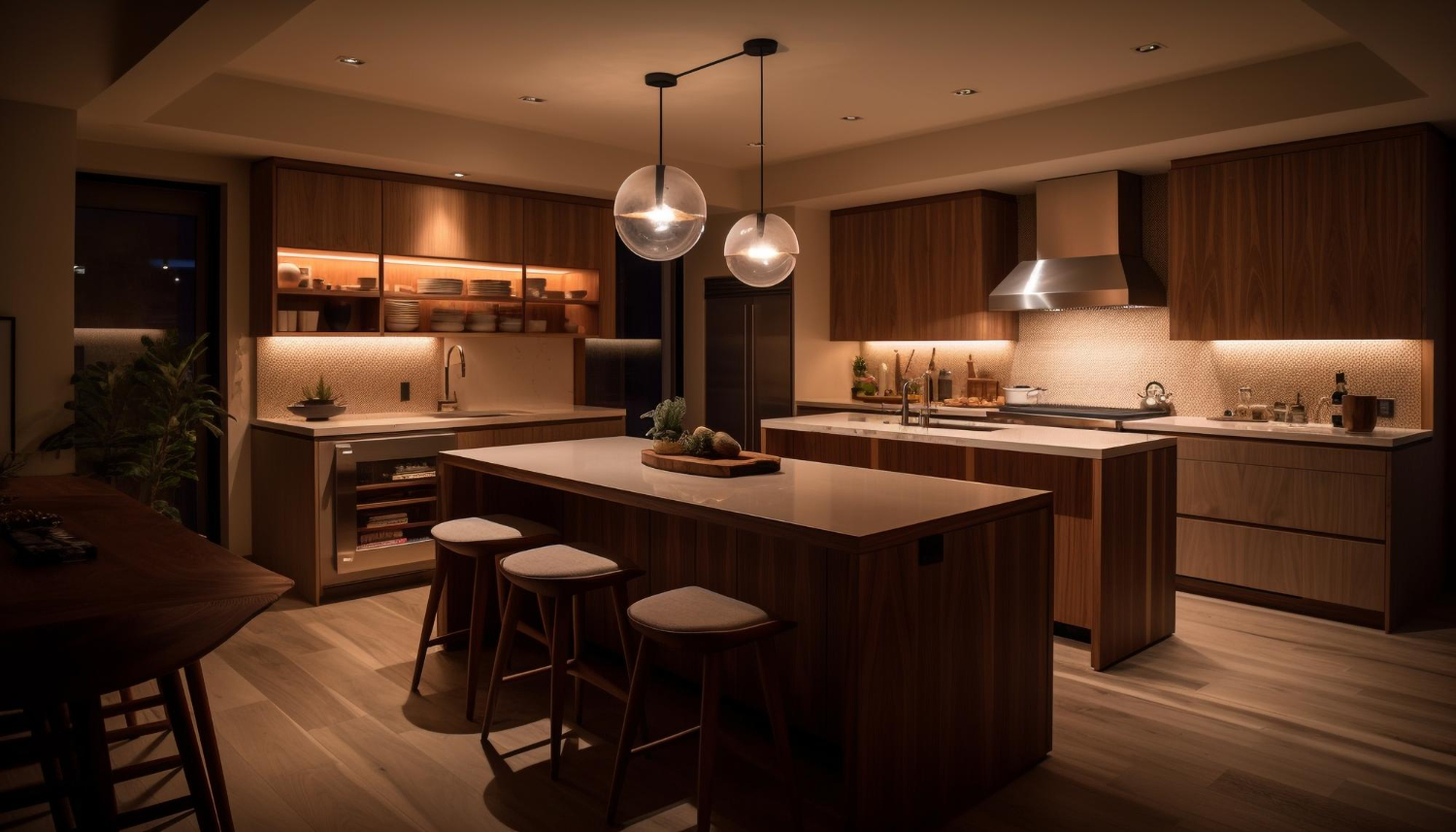Kitchen Lighting: The Complete Guide to Perfect Light Distribution
Introduction
In every elegant and functional kitchen, one detail makes all the difference: kitchen lighting. It’s not just about bulbs that illuminate the space, but a design system that impacts comfort, appearance, and productivity. Good lighting reveals the true colors of walls and food, increases the sense of openness and cleanliness, and gives the kitchen a refined, welcoming look. In this article, you’ll learn about the types of lighting in the kitchen and how to distribute kitchen lighting professionally, with tips for designing ceiling lighting, cabinet lighting, and pendant lighting.
Why Kitchen Lighting Matters
Lighting is a vital element that goes beyond aesthetics; it’s part of everyday safety and usability. The kitchen hosts cooking, cleaning, seating, and sometimes even work—so every zone needs the right light for its function.
Practical examples for lighting distribution:
| Zone | Ideal Lighting Type | Purpose |
|---|---|---|
| Cooking area | Task lighting or spotlights | Clear visibility during prep |
| Sink/washing area | Bright, cool lighting | Reveal fine details |
| Seating/breakfast nook | Warm, comfortable lighting | Create a cozy social atmosphere |
Ideal lighting balances beauty and function, preventing harsh shadows that make a kitchen feel cramped or uncomfortable.
Kitchen Ceiling Lighting
Kitchen ceiling lighting is the core of any successful design. It ensures even illumination and sets the overall mood of the space.
Common types include:
| Type | Advantages | Best Use |
|---|---|---|
| Recessed spotlights | Uniform light with no visual clutter | Low or modern ceilings |
| LED panels | High brightness with low energy consumption | General lighting for larger kitchens |
| Pendant lighting | Decorative statement with practical function | Above the island or prep table |
Pro tip:
Space recessed spots about 100 cm apart, and keep at least 60 cm from walls to avoid shadows on cabinets.
Distributing Kitchen Lighting
A key design goal is distributing lighting in the kitchen so it covers all work zones without visual noise.
Experts recommend three primary layers:
| Layer | Lighting Type | Function |
|---|---|---|
| Ambient lighting | Ceiling spots or LED panels | Illuminate the entire kitchen |
| Task lighting | Under-cabinet lights or above the island | Focus light on work surfaces |
| Accent/decorative lighting | LED strips or side lamps | Add visual sparkle and depth |
These layers work together to create balanced illumination, making the kitchen both practical and inviting.
Kitchen Cabinet Lighting
One of the most important design details is kitchen cabinet lighting; it highlights interior aesthetics and boosts usability.
Common types:
- Internal lighting for glass shelves: Adds visual depth and showcases glassware and dishes.
- Under upper cabinets: Provides clear visibility during prep and reduces shadows.
- Motion-sensor lighting: Turns on automatically when you open the cabinet—ideal for nighttime use.
| Type | Installation Method | Benefit |
|---|---|---|
| LED strips | Inside shelves or behind glass | Soft, decorative illumination |
| Under-cabinet lights | Mounted beneath upper cabinets | Practical lighting for worktops |
| Sensor-activated bulbs | Integrated into doors | Automatic on/off and smart convenience |
LED Lighting for Kitchens
LED kitchen lighting has become the most popular choice thanks to its efficiency, low energy use, and long lifespan.
Key benefits:
- Bright light with minimal heat.
- Multiple color temperatures to suit every style.
- Energy-saving with long service life.
| Lighting Type | Color Temperature | Best Use |
|---|---|---|
| Warm LED (3000K) | Comfortable, cozy ambience | Kitchen seating areas |
| Neutral LED (4000K) | Balance between warmth and clarity | Prep and cooking zones |
| Cool LED (5000K) | High clarity | Above the sink or on marble counters |
Tip:
Choose LEDs with a color rendering index of at least CRI 90 so colors look natural and food appears visually appealing.
Kitchen Pendant Lighting
Pendant lighting adds an artistic touch, especially in open or modern kitchens.
Notable styles:
- Linear bars: For long kitchens with a central island.
- Round glass pendants: For elegant, classic ambience.
- Black metal pendants: For bold industrial kitchens.
| Form | Ideal Height Above Table | Recommended Finish/Color |
|---|---|---|
| Linear bar | 75–90 cm | White or metallic grey |
| Three glass globes | ~80 cm | Gold or clear |
| Metal cylinder | 85 cm | Matte black or copper |
Design Tips for Kitchen Lighting
- Keep kitchen lighting distribution flexible, with separate circuits for each zone.
- Use dimmer switches to control brightness.
- Maintain a consistent light color across the space.
- Avoid glare on glossy surfaces.
- Plan the lighting layout before installing cabinetry to prevent costly changes.
Common Lighting Mistakes
- Relying on a single light source.
- Mismatched color temperatures between fixtures.
- Hanging fixtures too low.
- Ignoring corners and shadowed areas.
- Using low-quality bulbs or non–moisture-resistant fixtures.
Conclusion
The ideal kitchen lighting blends beauty with function. It’s not just task lighting for cooking, but a design element that adds warmth and elegance. Whether you choose ceiling lighting, cabinet lighting, or pendant lighting, ensure each layer is well planned and integrated with the others. Smart lighting doesn’t just beautify the kitchen—it makes every moment in it more comfortable and bright.
FAQs
What are the best types of kitchen lighting?
The best setups combine ambient lighting (spots or panels), task lighting (under-cabinet), and decorative accents such as LED strips or pendants above the island.
What’s the difference between warm and white light in a kitchen?
Warm light (3000K) creates a cozy, homely feel, while white light (4000–5000K) suits precise tasks and cooking thanks to its clarity.
How do I distribute lighting properly in the kitchen?
Start with even kitchen ceiling lighting, add kitchen cabinet lighting for worktops, and include a soft decorative layer for balanced aesthetics.
What’s the ideal height for pendants above the island?
Between 75 and 90 cm above the island surface for clear sightlines and even spread.
Is ceiling lighting alone enough?
No. General lighting alone casts shadows on work areas. Support it with under-cabinet task lighting and soft LED accents.
What light color works best for a small kitchen?
Neutral white (4000K) feels clean and spacious. Avoid overly warm or very cool light in compact spaces.
What’s the benefit of internal cabinet lighting?
It improves visibility inside cabinets and adds a touch of luxury—especially with LED strips or motion sensors.
Can I install LED lighting without new wiring?
Yes. Many LED strips run on rechargeable batteries or nearby outlets, making retrofits easy.
What mistakes should I avoid when installing lighting?
Placing spots directly over cabinet faces, mixing too many light colors, and using fixtures that aren’t resistant to moisture or heat.
How can I make kitchen lighting feel more luxurious?
Combine pendant lighting above the table or island with soft backlighting and concealed LED strips under cabinets for a refined, balanced glow.







